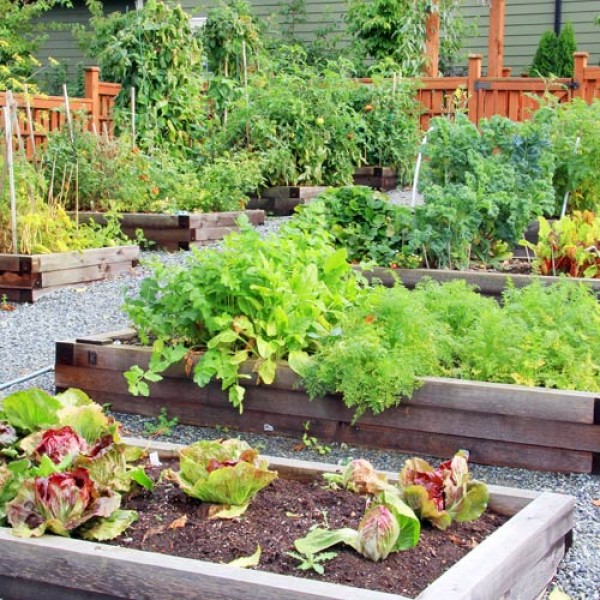Vegetable patch for beginners
Do you still have space in your garden and really want to grow your own fruit and vegetables? These are the perfect conditions for your own vegetable patch. Because food is becoming more expensive and you have to think about whether you would rather keep the free space in your garden low-maintenance or use it sensibly.
Good conditions for a vegetable patch?
The easiest way is to choose a rectangular bed shape that is no wider than 1.20 metres. You are free to choose the length, but if you want to create several beds, you should bear in mind that the paths between them should be wide enough to get through with a wheelbarrow.
The location should be as sunny as possible and preferably sheltered from the wind to ensure a good harvest. If the bed is in full sun, you may need sun protection in the hot months to prevent the plants from burning or wilting.
The order for planning the bed should be as follows:
1. choose your favourite vegetables and fruit
2. note what nutritional requirements fruit and vegetables have
3. which vegetable/fruit varieties are good neighbours, which are bad neighbours
4. how can the bed/beds be optimally divided?
If you are just starting out with gardening, you should of course only grow vegetables or fruit that you like to eat, but you should also be careful not to choose the most difficult varieties at the beginning.
Which vegetables are suitable for beginners?
1 Lettuce:
The seeds are simply scattered on the bed and not even covered with soil, as it is a light germinator. Just keep the seeds moist at all times, then nothing can really happen. Well suited for the bed: Tom Thumb lettuce, lettuce or the lettuce mix.
2 Swiss chard:
Swiss chard is easy to grow and can be harvested for the first time just 8 - 10 weeks after sowing.
3 Radishes:
They grow very quickly and can be harvested 3-4 weeks after sowing, depending on the variety
3 Turnip: As turnips are generally rather undemanding, they are very suitable for vegetable beginners. The Golden Ball turnip is particularly suitable,
4 Herbs / cress:
When planting herbs, you should know the preferences of the individual plants, as some need more sun or water than others.If you take these needs into account, you will have a colourful variety of flavours of Mediterranean, old-established and kitchen herbs in the bed.Well suited for planting in the bed are: Chives, lovage, mint and cress.
5 Spinach:
Even if spinach grows rather slowly at first, the first leaves can be harvested after just 6 - 8 weeks.
6 Tomatoes:
If the soil for the tomatoes is well prepared and already enriched with compost, seedlings can be seen within 8 - 14 days. If they get enough sun, they will quickly become small plants.Suitable for beginners: Meat or bottled tomatoes.
5 Spinach: Even if the spinach grows rather slowly at the beginning, the first leaves can be harvested after 6 - 8 weeks.
6 Tomatoes:
If the soil for the tomatoes is well prepared and already enriched with compost, seedlings can be seen within 8 - 14 days.If they get enough sun, they will quickly become small plants.Suitable for beginners: Meat or bottled tomatoes.
7 Broccoli:
Growing broccoli can be very rewarding, as smaller side shoots can be harvested for weeks after the central head has been harvested. If the soil has been enriched with compost before sowing, it only needs sufficient water for the next few weeks.
7 Cauliflower:
The versatile cauliflower is perhaps a little more demanding in the bed than other vegetables, but it is worth it.The cauliflower should be regularly cleared of weeds and watered sufficiently.
8 Courgettes:
Just one plant can cover the courgette requirements of an entire family, they are easy to grow and only need to be watered and fertilised regularly.
8 Pumpkin:
Pumpkins can be sown directly into nutrient-rich soil from May.Apart from a rich supply of nutrients, it requires very little care. Some even grow it directly on the compost.
Nutrient requirements of the plants:
Weak eaters: herbs, cress, radishes, lettuce,
Heavy eaters: broccoli, cauliflower, tomatoes, pumpkin, courgette, swede
Medium eaters:chard, spinach
Light requirements of the plants
Vegetables and fruit for the shade:Spinach
Vegetables for partial shade:Broccoli, cauliflower, lettuce, chard, cress, radish, pumpkin, courgette, turnip
Vegetables and fruit for full sun locations:Tomato, chard, herbs, pumpkin, courgette, swedes
Good neighbours - bad neighbours:
1 lettuce
Good neighbours: cabbage, beans, dill, peas, carrots, leek, onion, tomato
Bad neighbours: parsley, celery
2 Swiss chard
Good neighbours: turnips, broccoli, cabbage, lettuce, cress
Bad neighbours: spinach, beetroot, rocket, cucumber
3 Swede
Good neighbours: chard, carrot, chives
Bad neighbours: horseradish
4 Herbs / cress
5 Spinach
Good neighbours: cabbage, beans, tomato, radish, radish, strawberry, potato
Bad neighbours: beetroot, chard
6 Tomato
Good neighbours: lettuce, broccoli, carrots, corn, cauliflower, kohlrabi, spinach, cabbage, chilli
Bad neighbours: peas, potatoes, aubergine, fennel
7 Cauliflower
Good neighbours: beans, peas, cucumber, beetroot, spinach
Bad neighbours: potato, cabbage, leek, rhubarb, onion
7 Broccoli
Good neighbours: carrots, lettuce, Swiss chard, beetroot, cucumber, potatoes, rhubarb, Swiss chard
Bad neighbours: strawberries, rocket, kohlrabi, onions, savoy cabbage, cabbage
8 Courgettes
Good neighbours: onion, lettuce, chard
Bad neighbours: tomato, cabbage, cucumber
8 Pumpkin
Good neighbours: beans, corn
Bad neighbours: cucumber, courgette, tomato,
Beginner bed:
A possible bed plan for beginners can be found as the 2nd picture in the article, the example bed has the size:Width of 0.90 m and length of 4.0 m





















